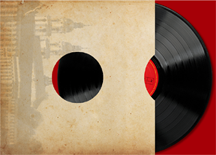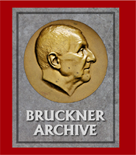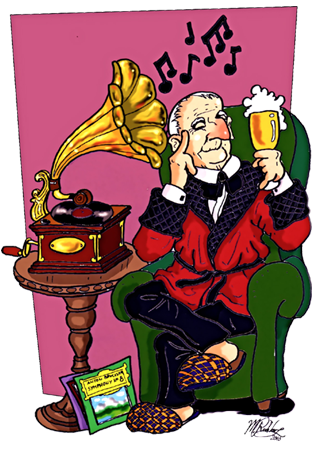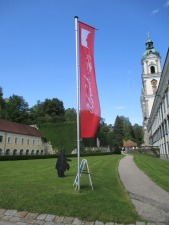A Report from the 2014 BrucknerTage at St. Florian
The Brucknertage, held annually at the Monastery of St. Florian in Austria, has been increasing in the scope of its programs in recent years and with it has come an increase in its audiences. It has been gratifying to watch this cultural event grow. Much of the surrounding countryside around Ansfelden - the birthplace of Anton Bruckner - and St Florian, appears to be as remote and rural as it was when Bruckner lived here. But just to the north of Bruckner’s historic birth house there is a bustling commercial area due to the nearby interchange on the Austrian Autobahn. The two wings of the highway, the A3 coming from Passau, Germany and the A1 from Salzburg and Graz, Austria merge just before the Ansfelden exit. For those coming to experience the life and work of Anton Bruckner, the clear choice is to move into the timeless regions away from the nearby highway. Upon arriving on August 20th, we first encountered conductor, Remy Ballot rehearsing the Northern Austrian Youth Orchestra in the Adagio of the Bruckner 8th. After a brief stop at the restaurant at St. Florian and some much needed rest, we went to our first official event. It was an evening lecture given in the Sala Terrena by Elisabeth Meier. The subject was the new book, “Die Bruckner-Bestaende des Stiftes St, Florian,” co-authored by Renate Grasberger and Ms. Maier. Both are known for their many publications devoted to the life and work of Anton Bruckner. This new publication is the first of three that is a catalog of the Bruckner holdings contained within the library at St. Florian. Prior to this, researchers did not know precisely what source material was held at the monastery. The program began with a short concert devoted to some of Bruckner’s earliest compositions. At the conclusion of Ms. Maier’s lecture, the musicians, violinist, Magdalena Kraus and pianist, Elias Gillesberger performed two additional works. Just prior to the concert, I was able to meet with representatives of the MWV and their distribution agent to discuss the possibilities of my offering their scores and publications for sale on my website. News on that topic will be forthcoming. The following morning, we sat in on a full rehearsal for Friday’s Bruckner 8th concert in the Stiftbasilika. Given that the theme of this year’s BrucknerTag was the 8th Symphony, the Thursday evening concert was a performance of the symphony in the edition by Karl Grunsky for 2 pianos, 4 hands. The mammoth undertaking was skillfully handled by pianists Franz Farnberger and the Brucknertag’s musical director, Matthias Giesen. Friday began with a morning drive to Ansfelden and a visit to the newly renovated Bruckner Museum in the Bruckner Geburthaus (birth house). The museum is rich in materials typical of the time in which Bruckner lived there, but it appears that genuine Bruckner artifacts are housed in other locations. Nevertheless, the planners have done a wonderful job in presenting the composer’s life with a clearly defined mission to expose school-aged children to Ansfelden’s rich cultural heritage. The afternoon event was a symposium which covered three main topics: 1) A personal & historic view of the Saint Florian by some of its visitors. 2) A discussion by Yale Professor, Paul Hawkshaw on his research of Bruckner’s Eighth Symphony which led to the recent publication of the long-awaited Critical Report of the score. 3) A discussion of Anton Bruckner’s somewhat troubled relationship with the Vienna Philharmonic Orchestra. Conductor, Gerd Schaller, who has given us some excellent and thought-provoking performances and recordings of Bruckner’s symphonies in recent years was on hand for the Symposium and for a lively discussion over lunch. Friday activities culmunated with an orchestral concert featuring a performance by the Jugend Sinfonieorchester Oberosterreich conducted by Remy Ballot. The concert took place in the Stiftbasilika. Invited guests listened from the organ loft and Paul Hawkshaw and I had the distinct honor of listening to the concert while sitting on the bench used with the Bruckner Organ. It was a remarkable concert in many ways. The Northern Austrian Youth Orchestra consists of an incredible group of young musicians. The conductor for these concerts is Remy Ballot and it is clear that there is a strong bond between conductor and orchestra. They will go whereever he leads them and he uses several rehearsals (both full and sectional) to take them on a fascinating musical adventure. Ballot's approach to Bruckner will not be to everyone's taste. He uses the acoustics of St. Florian and the willingness of his young musicians to create a massive architectural sound canvas that lasts over one hundred minutes and has one looking at the basilika's gloriously painted ceiling as a visual companion. The orchestra players, as young as they are, produce a sound that fills the hall with a rich robust blend. By the time the evening is over, one cannot escape the feeling that they have just witnessed a musical event. It is an interpretation that will not work in other surroundings and with other performers, but it works here and the forces behind this unique festival, namely Klaus Laczika, Julian Gillesberger and Matthias Giesen have created an event worthy of Bruckner's name. Being surrounded by good friends and colleagues simply enhanced the experience. |
|
Photo Gallery | |||








